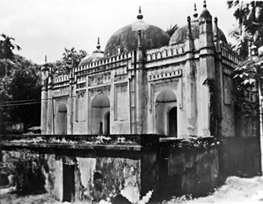Musa Khan Mosque
Musa Khan Mosque is located on the western side of the Shahidullah Hall of Dhaka University, and is less than half a km to the south of the Khwaja Shahbaz's Mosque. A high vaulted plinth with a three-domed mosque above and the grave of Musa Khan to its northeast comprise the mosque complex of Musa Khan. The whole complex was once enclosed by an outer wall, now completely gone.
The vaulted platform, 3.05m high, gives an outside measurement of 17.68m from north to south and 14.02m from east to west. Underneath the platform there are a series of rooms, now badly damaged. In the eastern side are three independent rooms, each of which could be entered from the east by a single archway.

Each of these rooms is again divided into two halves by a wide north-south horizontal arch. Further beyond on the west are three independent rooms, each being connected with the eastern one by an archway. The southern most room in the eastern side has an additional opening on the southwestern corner, which leads to a narrow passage along the southern side underneath the platform
The passage ends with a small opening on the southwestern corner of the plinth. All these rooms contain bookshelves at the waist of the walls. In the western side below the plinth are three other independent rooms, each opening towards the west by a single archway. In these three rooms, having the same constructional peculiarities like those in the eastern side, now reside some madrasa students.
The top of the platform can be reached by an elongated stairway on the southwestern corner. The mosque proper (14.94m ' 7.62m in the outside) occupies the western half of the platform. The four octagonal corner towers with extra minarets by their sides rise above the horizontal parapets and end in solid kiosks with cupolas on the top. The three arched doorways in the east, each opening out under a half-domed vault, consist of two successive arches - the outer one higher and wider than the inner one. The central doorway, bigger than its flanking counterparts, is set in a projected fronton with bordering ornamental turrets. Each of the north and south walls is also pierced with a single four-centred archway. The qibla wall is internally recessed with three semi-octagonal mihrab niches, which are all arched. The arch of the central mihrab is of multi-cusped variety, while those of the side ones are of plain four-centred type. The central mihrab, bigger than the side ones, is also projected outside having the usual ornamental turret on either side.
Of the three bays in the interior of the mosque the central one is bigger and square, 4.88m a side. Each of the smaller side bays measures 4.88m by 3.05m. Above the roof there are three shouldered domes on octagonal drums, one over each bay. The central dome is larger than the side ones and carried on two east-west wide arches together with four small half-domed squinches on the upper angles. The comparatively smaller side domes are supported by the traditional half-domed vaults on the east and west walls, the upper corners here are filled with triangular pendentives.
The under-ceilings of the vaulted rooms below the platform were originally embossed with tiered rosettes in stucco at intervals, traces of which still remain here and there. The eastern facade of the mosque proper originally had panels, but now made plain by applying cement plaster in recent times. The horizontal parapets are faced with rows of blind merlons. The octagonal drums have both internally and externally a basal course of merlons. All the domes are crowned with lotus and kalasa finials. The apex of each dome in the inside is decorated with a large painted medallion. The entire building, both inside and outside is now covered with cement plaster and washed white with lime.
The mosque had an inscription tablet over the central doorway, now missing. It is traditionally ascribed to musa khan (died in 1623), son of the famous Bara Bhuiyan chief isa khan. But the architectural style of the building does not conform to the tradition. In its panelled facade, the doorways opening out under half-domes, shouldered domes on octagonal drums and corner towers with extra minarets by their sides the so called Musa Khan's Mosque bears the closest similarity with the nearby Khwaja Shahbaz's Mosque (1679). A contemporary date may therefore be suggested for the building. AH Dani, however, thought that the mosque was possibly built in the time of shaista khan or even later by dewan manawar khan, grandson of Musa Khan. And in memory of his grandfather the builder named it after Musa Khan.
Like the Chawk Mosque (1676) and some others of the kind in the city of Dhaka, this mosque is built on a high terrace containing underneath a series of vaulted rooms with book-shelves on the walls. This particular specialty of the building suggests that it also must have originally been built as a 'madrasa mosque'. [MA Bari]
